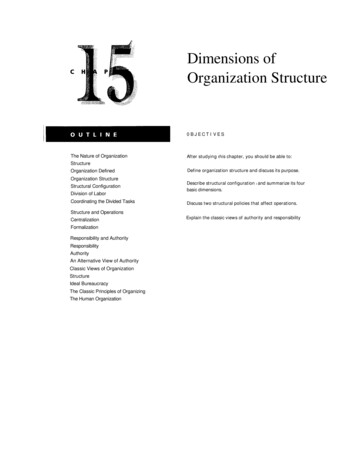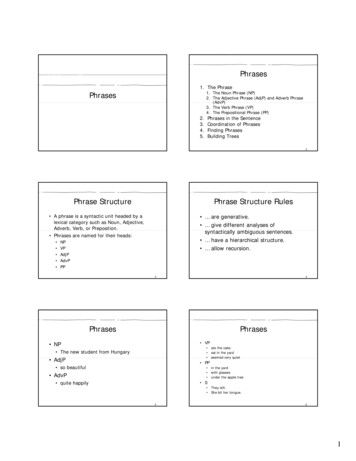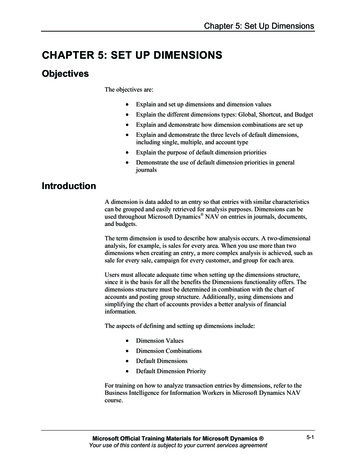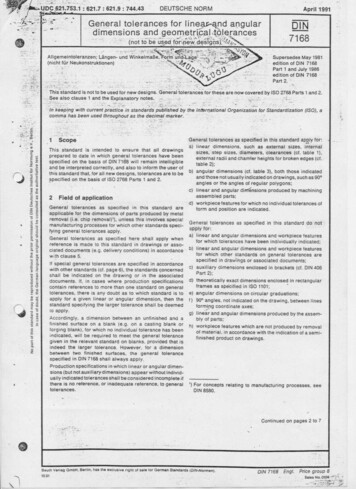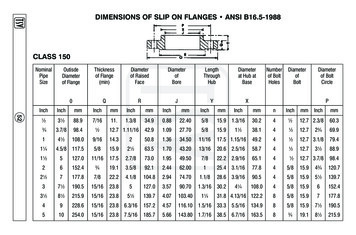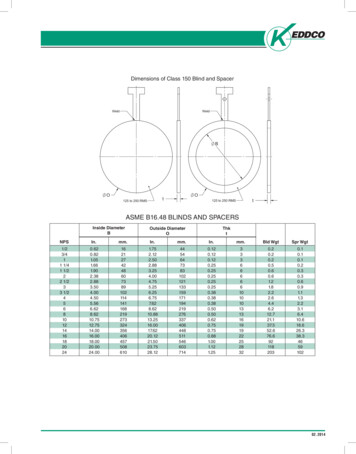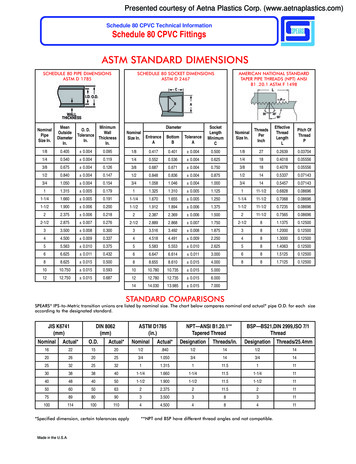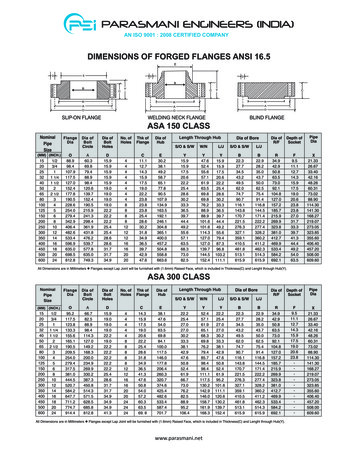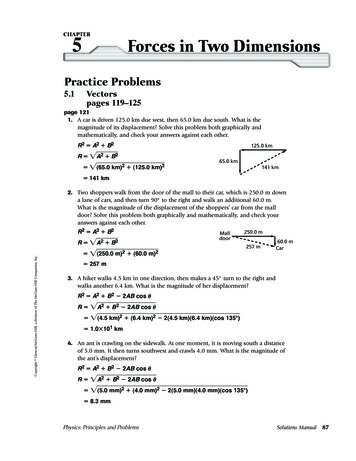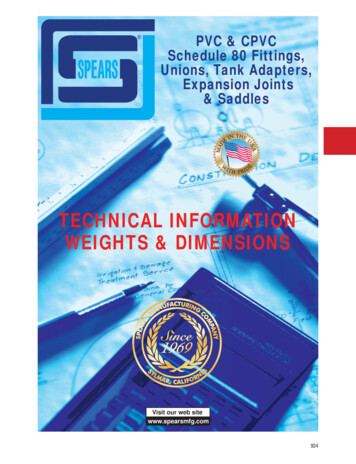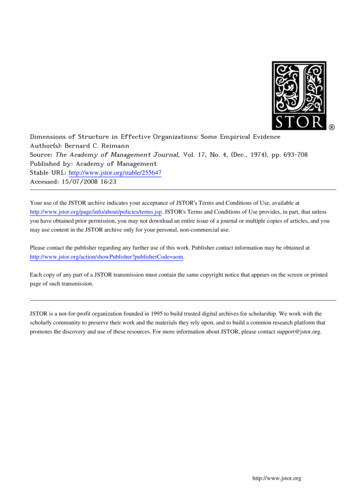
Transcription
Dimensions of Structure in Effective Organizations: Some Empirical EvidenceAuthor(s): Bernard C. ReimannSource: The Academy of Management Journal, Vol. 17, No. 4, (Dec., 1974), pp. 693-708Published by: Academy of ManagementStable URL: http://www.jstor.org/stable/255647Accessed: 15/07/2008 16:23Your use of the JSTOR archive indicates your acceptance of JSTOR's Terms and Conditions of Use, available rms.jsp. JSTOR's Terms and Conditions of Use provides, in part, that unlessyou have obtained prior permission, you may not download an entire issue of a journal or multiple copies of articles, and youmay use content in the JSTOR archive only for your personal, non-commercial use.Please contact the publisher regarding any further use of this work. Publisher contact information may be obtained herCode aom.Each copy of any part of a JSTOR transmission must contain the same copyright notice that appears on the screen or printedpage of such transmission.JSTOR is a not-for-profit organization founded in 1995 to build trusted digital archives for scholarship. We work with thescholarly community to preserve their work and the materials they rely upon, and to build a common research platform thatpromotes the discovery and use of these resources. For more information about JSTOR, please contact support@jstor.org.http://www.jstor.org
EmpiricalEvidence'BERNARD C. REIMANNUniversity of PennsylvaniaA study of 19 manufacturing organizations revealedstructural differences between relatively high and lowperforming organizations. Cluster analyses of the correlations among eleven measures of structure isolatedthree relatively independent dimensions of (a) decentralization, (b) specialization, and (c) formalization amongthe ten high performing firms, but failed to produce anysuch independent dimensions among the low performingfirms.In recent years a number of scholars have attempted to isolate empiricallythe underlying dimensions of organization structure. While many of theseresearchers have used Weber's (3) basic model of bureaucracy as a pointof departure, their findings have been somewhat at variance, particularlywith respect to the relationships among the various dimensions of bureaucracy (2,4, 10, 11).Hall (4) was one of the first to question Weber's unidimensional conceptof organization structure, according to which organizations are highlybureaucratic to the extent that dimensions such as the following six arepresent or absent:1.2.3.4.5.6.Well-defined hierarchy of authorityDivision of labor based on functional specializationRules covering rights and duties of positionsProcedures for dealing with work situationsImpersonality of interpersonal relationsEmployee selection and promotion on the basis of technical competence.Bernard C. Reimann (D.B.A.-KentState University) is Assistant Professor of Management, The Wharton School, University of Pennsylvania, Philadelphia, Pennsylvania.1 Portions of this paper were presented at the Seventeenth Annual Meeting, MidwestAcademy of Management, Kent State University, April, 1974.693
694Academy of Management JournalDecemberHall conceived of these dimensions as continua representingan organization's degree of bureaucratization. He measured his dimensions by meansof Likert-type scales administered to random samples of employees in tenorganizations, half of which were nonprofit government agencies, theother half business firms. Since none of the correlations among his sixdimensions reached significance (p .05), Hall concluded that "themagnitude of the dimensions varied independently in the organizationsstudied" (4, p. 39).Hall's study suffered from two basic weaknesses, however. Due to thesmall size of his sample, its heterogeneity (government agencies as wellas business firms) may have been more of a hindrance than a help forpurposes of making generalizations. This heterogeneity reduced the likelihood of strong correlations between bureaucratic "dimensions" on theone hand, while the smallness of the sample required very high correlationcoefficients to reach "significance,"on the other.A second possible weakness of Hall's research was his use of perceptualdata. The magnitudes on his dimensions reflected the perceptions of thosedimensions by organization participants. Whether this is better or worsethan other approaches which might reflect, for example, the biases ofresearchers, is, of course, debatable.A subsequent research study by the Aston group (10) did not, however,suffer from these weaknesses, yet it reached essentially similar conclusions.The Aston group studied some 46 British work organizations (primarilyprofit-oriented manufacturing or service organizations), measuring structural variables by observation and interviews with executives, and makingit a point to use no perceptual data. By means of a factor analysis oftheir structural measures, the Aston researchers derived four independentfactors or underlying dimensions of structure: (a) structuring of activities,(b) concentration of authority, (c) line control of workflow, and (d) sizeof supportive component.A recent replication of the Aston study by Child (2) produced somewhat different results. The first two Aston factors of structuringof activitiesand concentration of authority merged into a single bi-polar "administrativecontrol" dimension in Child's factor structure (unrotated). This bi-polarfactor was defined by a high negative loading on concentration of authority(or centralization), and positive loadings on structuring (formalizationand specialization). That is, for the 82 organizations in Child's study,centralized firms tended to be relatively unstructured and decentralizedfirms relatively structured. Child concluded, therefore, that his resultsprovided support for an administrativestrategy of controlling the behaviorof organization members either by centralization of authority or by structuring of their activities through formalized standards and procedures and byfunctional specialization.A possible reason for the difference between Child's results and thoseof the Aston group may be found in a basic difference in their samples oforganizations. The Aston sample consisted of organizations with varying
1974Volume 17, Number 4695degrees of dependence on other organizations (i.e., branch plants, subsidiaries, etc.); Child examined only legally independent organizationalunits.A recent comparative study of 19 Northeast Ohio manufacturing plants(11), also with varying degrees of dependence, and using the Aston group'sapproach, produced three independent bureaucratic structure dimensions.Both factor and cluster analyses revealed separate dimensions of (a)decentralization, (b) specialization, and (c) formalization; that is, theAston group's single structuringof activities factor formed two independentdimensions of specialization and formalization in this study of Americanfirms.A basic issue raised by the research studies cited is the extent to whichthe bureaucratic aspects of centralization of authority, specialization, andformalization tend to occur together in complex organizations. Accordingto Child, they all tend to be strongly related to form a single unidimensional"strategy of administrative control." The Aston study (10) suggests thatformalization and specialization vary together, but are, in turn, independentof decentralization. Finally, the studies by Hall (4) and Reimann (11)indicate that these three bureaucratic dimensions may all vary quite independently; that is, an organization can be highly formalized, and eithercentralized or decentralized, and specialized or nonspecialized.The differences in findings among these research studies demonstratethat the existence of underlying and perhaps universal dimensions ofstructure is very much open to question. One strong possibility is that thedimensionality of the organization structure space, rather than beinguniversal, may be contingent on the types of organizations studied and thekinds of situations or environments in which they exist. Further researchmay reveal, for example, that differences in their sociocultural environments have resulted in a more complex structure space, with more independent dimensions, for industrial organizations in the United States thanmight be found among their counterparts in Great Britain or other European countries. Another possibility is that the dimensionality of organizationstructure may be related to organizational performance. None of theresearch studies cited have examined organization structure in relationto organizational effectiveness.THE STUDYThe research reported in this article was designed to examine the relationship between the underlying dimensions of structure and organizationalperformance. More specifically, answers to the following two relatedresearch questions were sought:1. What differences, if any, exist between the structural dimensions ofrelatively high and low performing organizations?2. If different from those of low performing organizations, what arethe dimensions associated with the relatively high performingorganizations?
696Academy of Management JournalDecemberSample and MethodThe sample for this study consisted of 19 Northeast Ohio industrialorganizations in a wide range of sizes (220 to 4,000 employees), manufacturing a variety of products. Data were gathered from personal interviews with from four to ten top executives (depending on the size of themanagement team) in each firm, and by consulting available documentssuch as organization charts, standard operating procedures, or policymanuals.Organization EffectivenessThe measurement of the relative effectiveness of the industrial organizations in this study presented some difficulties. Data on the various financialindices commonly used to measure this aspect of performance were notavailable for the majority of organizations, since these data are rarelybroken out for subsidiaries or branch plants. Data on many nonfinancialindices were just as difficult to obtain.It was decided, therefore, to base the measure of the organization'srelative effectiveness on the perceptions of its top executives. This typeof measure was recently employed by Lawrence and Lorsch (8), whoasked executives to rate their organization's overall performance relativeto others in their industry on a scale of 0 to 100 percent, with 100 percentregarded as the optimum or ideal performance. In the present study,executives similarly were asked to rate their organization's performance,but on each of eight different criteria.The first two were the financial criteria of average growth for the pastfive years in (a) sales and (b) profits. The six nonfinancial indicatorsincluded: (a) The firm's ability to attract and retain high-level manpower,(b) satisfaction and morale of employees, (c) quality of the firm'sproducts,(d) service to customers, (e) future growth potential (sales and/or profits),and (f) the rating which its competitors would be expected to give thefirm for its overall performance.A criterion score was determined for each firm on each of the eightcriterion measures by (a) computing the mean response for each criterionand (b) assigning a rank score to each firm on every criterion. The internalconsistency of rankings assigned firms on the eight criteria was high(Kendall's coefficient of concordance was 0.385, significant at the .001level); therefore all eight criterion scores were combined to give an overallscore for each firm. This score represented the organization's relativeeffectiveness as perceived by its top management group.The objectivity of the executive's responses to the two financial indicatorscould be checked by comparison with actual financial data for six of thenineteen firms where such information was obtainable. Spearman's rankcorrelation coefficients of .95 and .83 were obtained, respectively, forsales and profit growth for the last five years. The fact that both of thesecoefficients were significant (p .05) suggested that the executive rank-
1974Volume 17, Number 4697ings of the relative financial performance of their firms correspondedclosely to reality, at least for the six firms in question.In addition to the subjective criteria, an objective criterion of "behavioral"effectiveness was also employed-voluntary turnover among top to middlelevel executives for the past two years. This executive turnover measureprovided an indication of general morale and work satisfaction of topmanagement. Based on the assumption that the more effective the organization, the happier and less frustrated its top managers and vice versa, it wasfelt that the organization's sucess in retaining its top executives would provide an indirect indicator of its overall effectiveness. Moreover, this measurewas quite objective, since each executive was asked whether any of hisfellow executives had left of their own accord in the past two years. Onthe basis of a consensus of these executives, a reasonably accurate numberwas established. In order to calculate the turnover rate, this number wasexpressed as a percentage of the total group of executives considered.Depending on the firm's size and organizational setup, the total group ofexecutives varied in number from about 12 to 40.The scores of the nineteen firms on the various effectiveness criteria aresummarized in Table 1.Organization StructureOrganization structure was conceptualized in a multidimensional framework, as suggested recently by the Aston researchers (10). Therefore, thebulk of the structural measures used in this study were based on the abbreviated scales published by the Aston group (5). In addition, a structuralmeasure developed by Negandhi and Prasad (9) was used, along withseveral others adapted from measures reported in the literature. The detailsof the scaling of these measures have been desc
sidiaries, etc.); Child examined only legally independent organizational units. A recent comparative study of 19 Northeast Ohio manufacturing plants (11), also with varying degrees of dependence, and using the Aston group's approach, produced three independent bureaucratic structure dimensions. Both factor and cluster analyses revealed separate dimensions of (a) decentralization, (b .Cited by: 83Page Count: 17File Size: 415KBAuthor: Bernard C. Reimann
